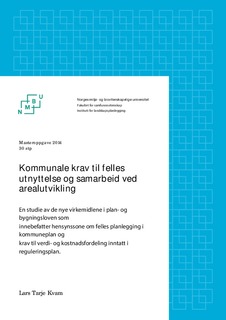| dc.description.abstract | This thesis looks at the relationship between the Land Consolidation Act and the Planning and Building Act regarding the use of the instruments “joint planning” and ”urban land consolidation”. Joint planning includes the use of the consideration zone “joint planning” in the land use plan in the municipality, the continuation of such consideration zone in a subsequent zoning plan or the inclusion of provisions regarding distribution of land values and costs in the zoning provisions. Urban land consolidation consists of two new instruments witch the land consolidation court may hold proceedings for. One instrument is a distribution tool that can be used to allocate plan created land values. The other is a remedial measure where the land consolidation court can use the other instruments in the Land Consolidation Act § 2 to alleviate disadvantages resulting from the implementation of allocated regulating purposes.
It is therefore in the land use and zoning plans for the municipality possible to set a requirement that landowners must cooperate on development within a limited area. By taking such demands into plans, it lowers the consensus requirement for the use of land consolidation after the aforementioned instruments in the Land Consolidation Act from full consensus to 2/3 consensus.
There is only marginally set such requirements into the plans at the municipal level. This thesis seeks to shed light on why it is so. For this reason, it is conducted a survey on municipal knowledge, their use of these instruments and whether they see a need for such measures.
Municipalities mainly provide feedback that they are aware of the instruments in the Planning and Building Act, but most have not yet started using them. Regarding the instruments in the Land Consolidation Act there are few who are familiar with these. Municipalities see that measures to promote integral planning are helpful in securing a better utilization of space. They are primarily also positive that it allows a grounds for enforcement to the implementation of plans, but as with any other enforcement measure usage may be controversial. City municipalities mostly see how this can be used actively, while the rural municipalities had not taken a position on this. This may indicate that it is most foreseeable that such instruments will be used where there is a greater pressure on land.
The most obvious problem for an active exploitation of these instruments is that the municipalities do not have enough depth knowledge of how these instruments can be used and to what effect.
Sammendrag
Denne oppgaven tar for seg samhørigheten mellom jordskifteloven og plan- og bygningsloven når det gjelder bruk av virkemidler til ”felles planlegging” og ”urbant jordskifte”. Felles planlegging omfatter bruk av hensynssonen ”felles planlegging” i kommuneplan, en videreføring av en slik hensynssone i etterfølgende reguleringsplan eller at det tas inn bestemmelser om fordeling av arealverdier og kostnader i reguleringsplansbestemmelsene. Urbant jordskifte består av to nye virkemidler som jordskifteretten kan fremme sak etter. Det ene virkemidlet er et fordelingsvirkemiddel som kan benyttes for å fordele planskapte arealverdier. Det andre er et avbøtingsvirkemiddel hvor jordskifteretten kan benytte de øvrige virkemidlene i jordskifteloven § 2 til å avhjelpe ulemper som følger av gjennomføring til avsatt reguleringsformål.
Det er i kommunens planlegging derfor mulig å sette krav om at grunneiere må samarbeide om utvikling innen et avgrenset område. Ved å ta inn slike krav i plan så senker det enighetskravet for å fremme jordskifte etter de nevnte virkemidlene i jordskifteloven fra full enighet til 2/3.
Det er i liten grad satt slike krav inn i planer på kommunalt nivå. Denne oppgaven søker å belyse hvorfor det er slik. Av denne grunn er det foretatt en undersøkelse om kommunenes kjennskap til, deres bruk av og om de ser et behov for slike virkemidler.
Kommunene gir i hovedsak tilbakemelding om at de kjenner til virkemidlene i plan- og bygningsloven, men de fleste har ikke tatt disse i bruk. Når det gjelder virkemidlene i jordskifteloven så er det få som kjenner til disse. Kommunene ser at virkemidler som fremmer en helhetlig planlegging er nyttig i å sikre en bedre arealutnyttelse. De er i hovedsak også positive til at det åpner for et tvangsgrunnlag til gjennomføring av planer, men som ved annen tvangsbruk kan være kontroversielt. Av bykommuner så ser de fleste for seg hvordan dette kan brukes aktivt, mens hyttekommunene ikke hadde tatt stilling til dette. Det kan tyde på at det er mest påregnelig at slike virkemidler vil benyttes der hvor det er et større press på arealene.
Det mest tydelige problemet for en aktiv utnyttelse av virkemidlene er at kommunene ikke har nok inngående kjennskap til hvordan de skal benyttes og den reelle virkningen av dem. | nb_NO |
